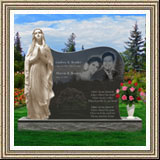When someone passes away, many people, including relatives, co-workers, business associates, childhood friends and casual acquaintances may wish to pay their final respects. The immediate family may not be familiar with these individuals and in their bereavement, they might not remember seeing those they do know. This is one reason funeral books are part of the standard preparations.
These ledgers actually serve multiple purpose. Primarily, they give people who want to show respect and support the opportunity to let the family know that they are not alone in their grief. Knowing so many others care is often a great comfort to the close relatives.
Guest ledgers come in several sizes, styles and formats in order to meet the preferences of a wide range of people. Traditionally, a physical book is set out on a table near the entrance to the venue and individuals sign their names as they arrive. Modern technology has introduced the virtual version which affords the same opportunity to those who wish to pay respects but are unable to make an appearance in person for whatever reasons.
The physical types are available in quite a few different styles, each having hundreds of design variations. Some families prefer to keep things simple and use a ledger that provides space for guests to leave only basic information like a name, address and how they knew the deceased. Others find it comforting to have pages that allow room for memories and condolences to be written and shared.
Virtual versions of these ledgers can be set up online. These are also available in many design layouts ranging from simple registers to those which allow visitors to share personal thoughts, memories, photos and videos. A lot of hosting sites will have a way for the family to order either digital copies of the entries or printed ones.
Each type of register can be a form of comfort to the family, which is why it is becoming popular to have both in place. More people are able to express their support. This may be quite healing when going through the grieving process.





